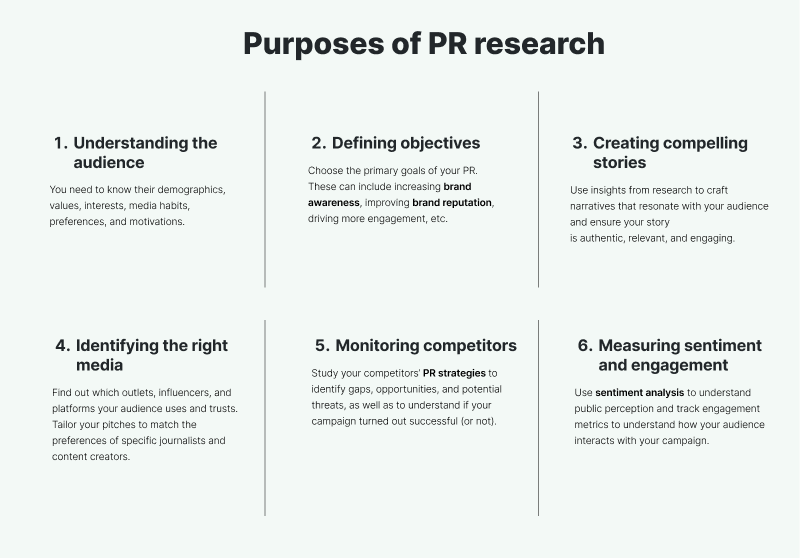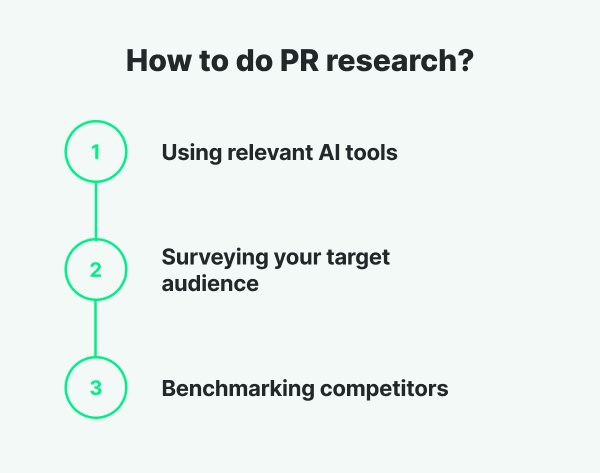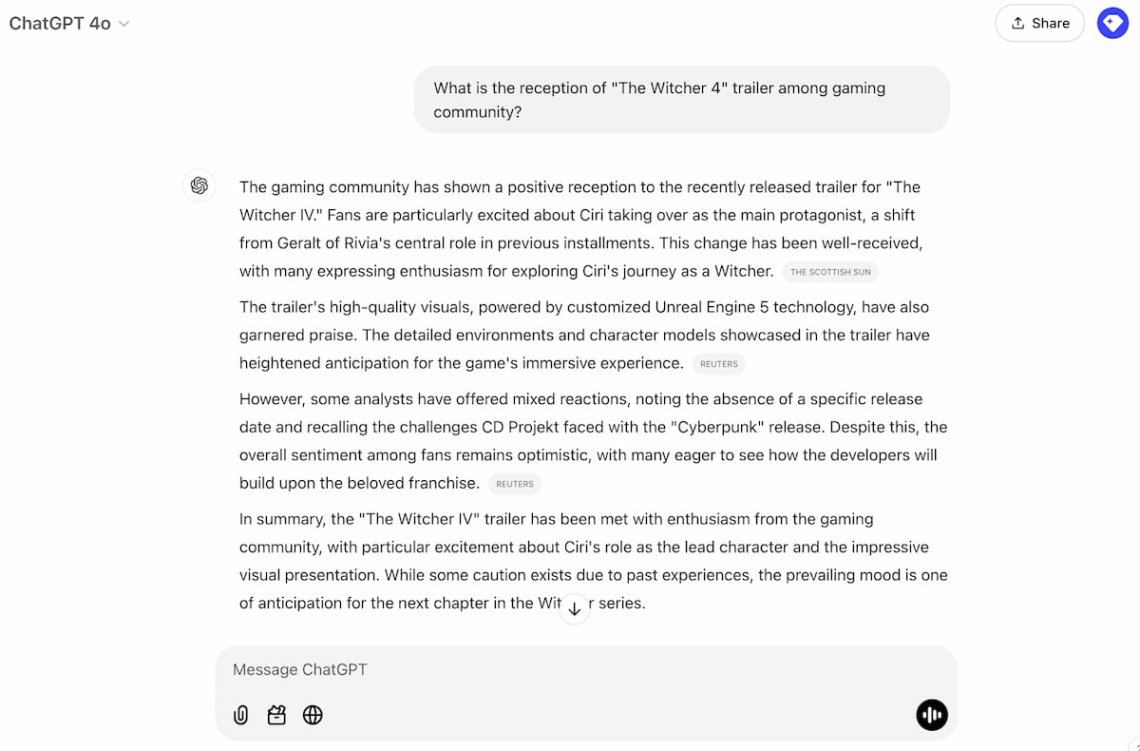How to Do PR Research in Less than 30 Minutes?
Table of contents
Public relations research is an essential, yet often underestimated, component of the PR process. Many businesses see it as a complex and time-consuming effort that is not worth the investment. What a miss! With well-designed PR research, you can effectively enhance your communication strategies and achieve outstanding outcomes. The best part? If you use the right method, it takes less than 30 minutes! Ready to learn the three magic spells?
PR research is a process of collecting, analyzing, and evaluating information to help organizations understand their audience, customize communication strategies, manage crises, and measure the effectiveness of public relations efforts.
All these are to make data-driven decisions that maintain and strengthen a positive brand reputation.
What is PR research? Definition
Imagine you’re playing an open-world video game (like The Witcher or GTA).
At the beginning, the map is totally blurred. You don’t know what lies ahead, where the key locations are, or what challenges you might face.
As you explore, the map gradually becomes clearer. You uncover hidden treasures, discover key locations, and learn how to get there without getting lost. And here the fun begins!
Public relations research works in the same way.
Initially, your understanding of your audience, their preferences, the best communication channels, or the challenges your message might face can be unclear, like a blurry map.
But as you delve into research, the “map” of your PR landscape starts to reveal itself.
This process is both methodical and dynamic, consisting of three essential steps: gathering, analyzing, and evaluating data:
- Gathering is like taking the first steps in exploring the game world. It focuses on collecting relevant information about your target audience, competitors, market trends, and media landscape.
- Analyzing transforms this raw data into actionable insights, helping you to identify patterns, correlations, and opportunities. It resembles understanding how the landmarks on your map connect.
- Evaluating assesses the impact of your PR efforts by measuring outcomes against predefined goals. This helps refine your strategies and ensure you stay on the right course.
Do your PR research effortlessly!
Purposes of Public Relations Research

Public relations covers a wide range of topics, from crafting compelling narratives to building strong relationships with stakeholders.
Effective PR research ensures that every aspect of a campaign is data-driven and targeted.
Here are the 6 key purposes of that process:
- Understanding the audience. You need to know their demographics, values, interests, media habits, preferences, and motivations.
- Defining objectives. Choose the primary goals of your PR. These can include increasing brand awareness, improving brand reputation, driving more engagement, etc.
- Creating compelling stories. Use insights from research to craft narratives that resonate with your audience and ensure your story is authentic, relevant, and engaging.
- Identifying the right media. Find out which outlets, influencers, and platforms your audience uses and trusts. Tailor your pitches to match the preferences of specific journalists and content creators.
- Monitoring competitors. Study your competitors’ PR strategies to identify gaps, opportunities, and potential threats, as well as to understand if your campaign turned out successful (or not).
- Measuring sentiment and engagement. Use sentiment analysis to understand public perception and track engagement metrics to understand how your audience interacts with your campaign.
Try the best PR research tool ever!
How to do PR research?
Okay, enough theory! It’s time to show you how to do PR research in practice.
As you can see, there are many elements of public relations research. Is there a trustworthy method to conduct it fast and – more importantly – flawlessly?
Yes! All you need to do is combine three tactics:
- Using relevant AI tools
- Surveying your target audience
- Benchmarking competitors.

Step 1: Ask AI tools
My experiences have been proving that you can perform really well quantitative and qualitative research in just 30 minutes.
Seriously, we’re really lucky to live in an era when AI tools can take much time-consuming work for us. The trick here is to use the right tools in the right way. What do I mean?
Well, there are many AI tools available. The most popular ones, like ChatGPT, Gemini, and Perplexity, can compile large volumes of data into concise and actionable insights in seconds.
For example, I prompted ChatGPT to provide me with a snapshot of the reception of the “The Witcher 4” trailer among the gaming community.
The tool provided me with some quotations – unfortunately, they were quite basic and based on information from just a few sources.
In fact, you could get the same insights and conclusions in 5 minutes by googling them.

The real game-changers are AI tools that provide much more detailed information. Perfectly if these tools have access to internal data that are not widely available.
One such tool is Brand24 and, specifically, its feature named AI Brand Assistant.
Brand Assistant is a machine learning & natural language processing-powered feature that accesses internal data of your tracked project.
Depending on your prompt, it can provide you with detailed stats, comparisons, competitor benchmarking, insights, and recommendations based on real-time, filtered internal data.
Let’s put it this way: if a ChatGPT looks like a gym newcomer, a Brand Assistant is like Arnold Schwarzenneger in his prime.

Enjoy the help of your personal AI Brand Assistant!
When I asked Brand Assistant the same question – about the reception of “The Witcher 4” trailer among the gaming community – the tool gave me a lot of detailed and accurate insights, such as:
- The list of key mentions alongside platforms they were published,
- The overview of mentions’ reach and sentiment stats,
- Mentions’ volume, reach, and sentiment charts;
- A quick summary.
This is just one of many examples of how public relations professionals can use AI Brand Assistant for PR research!
Especially for you, I prepared a list of the top 10 prompts you can use to do your research:
- What are the key characteristics and preferences of our target audience based on recent social media mentions?
- What are the key elements of successful PR stories in our industry, and how can we incorporate them into our narrative?
- Which media outlets and influencers should we target for maximum reach and engagement for our campaign?
- Can you provide a list of top media channels that have previously covered similar products or topics?
- Can you provide an analysis of our competitors’ recent PR activities and their impact?
- What is the overall sentiment trend for our brand over the past month, and how does it compare to our competitors?
- Can you provide insights into which types of content are driving the most engagement for our brand?
- Can you help define clear and measurable PR objectives for our upcoming campaign?
- Can you identify emerging trends and topics in our industry that we should focus on in our PR efforts?
- What were the key drivers of success for our latest PR campaign, and what areas need improvement?
Below, you can see the response I received from the Brand Assistant when I prompted it about some PR recommendations based on CD Projekt’s latest online performance.
The feature analyzed the mentions from the project and recommended to increase engagement and hype around The Witcher 4 trailer, to collaborate with tech influencers, and much more ready-to-implement suggestions!
Want to know answers to other questions? Check them by yourself!
Try Brand24 – the best AI-powered PR research tool!
Step 2: Ask the target audience
Let’s make it clear – you can’t do good PR research without knowing your target audience. AI tools are incredibly helpful, but nothing can replace human-human conversations.
Always keep in mind that PR communication is made for people and people only.
Therefore, the next step in your public relations process of research is to engage with your target audience directly.
This increases your chances of crafting messages that truly resonate and address their specific needs and expectations.
Here are the top 3 techniques of target audience research:
- Surveys. A primary method for collecting quantitative data from your audience. In practice, you can use tools like Google Forms or SurveyMonkey. When doing surveys, remember about three essentials:
- A representative sample size to have a statistically correct number of responses;
- To get diverse insights, use different question types (multiple-choice, open-ended, Likert scale, etc.);
- Promote your survey, i.e., through email, social media, and targeted ads.
- Interviews. It is probably the best technique for deeper qualitative research. They allow you better to understand the motivations and feelings of your audience.
- Social listening. Monitoring social media platforms for trending topics, popular comments, and engaging discussions can give you a broader understanding of your audience’s feelings and concerns.
For example, Brand24 offers an AI Topic Analysis.
This feature uses artificial intelligence to cluster mentions about similar issues. It means that instead of spending hours on manual analysis, you can quickly identify your audience’s top areas of interest.
Surveys and interviews offer incredible results but require patience.
Therefore, if you need to do your research as soon as possible, social listening becomes your go-to method. It allows you to gather real-time insights without waiting.
Discover your top topics with Brand24 now!
Step 3: Benchmark with competitor
You see, I don’t like reinventing the wheel.
My personal opinion is the following: if something works well for others, why not learn from their success and adapt it to your strategy?
This is where benchmarking your competitors becomes an indispensable tool in PR research.
Competitor analysis involves studying your rivals’ public relations efforts to identify what strategies resonate with their audience, what mistakes to avoid, and what opportunities you can capitalize on.
Additionally, benchmarking allows you to understand where your brand stands in the competitive landscape.
It shows what your competitors are doing well, what they might be missing, and how you can use this information to improve your own strategy.
Okay, and how to do it fast? The answer is simple: use the right tool!
Let me show you it in the example.
As you might have guessed, I’m a big fan of video games.
Right now, I’m absolutely thrilled about two upcoming titles: The Witcher 4 by CD Projekt and GTA 6 by Rockstar Games.
Both companies are heating up the atmosphere about their in-progress flagship games. Who does it better? Let’s check it!
I used Brand24’s Comparison feature to set aside CD Projekt’s and Rockstar Games’ PR performance in the last 30 days.
It turned out that – in general – both brands go head-to-head. CD Projekt is better at getting coverage from non-social sources, such as news sites, blogs, podcasts, and video platforms.
On the contrary, Rockstar Games’ does better in social media. The conclusion?
The winner depends on the audience you’re targeting.
If you want to capture the attention of a more diverse and information-driven audience, CD Projekt’s approach is the way to go.
But if your goal is to generate immediate excitement and social buzz, Rockstar Games sets the benchmark.
Understand your competitors & overpower them!
Conclusion
PR research doesn’t have to be daunting or time-consuming!
By combining the right strategies and tools, you can complete effective research in under 30 minutes. Start by finding a human-artificial intelligence link. Why?
Because AI-powered solutions like Brand24’s AI Brand Assistant simplify the whole public relations research process, turning complex and massive amount data into quick and actionable insights.
If you complement this with direct or indirect audience feedback through surveys, interviews, or social listening, you’ll uncover insights that AI alone can’t provide.
Add competitor benchmarking into the mix, and you’ll spot gaps in the market, identify emerging opportunities, and learn which tactics work best in your industry.
Together, these methods help you craft and measure PR campaigns that are precise, relevant, and competitive, ensuring your brand stands out in a crowded market.
Final thoughts:
- AI tools like Brand24 transform data into a practical resource, not an overwhelming task.
- Listening to your audience directly ensures your campaigns speak their language.
- Competitor insights guide smarter decisions and reveal what others might be missing.
Start your PR research journey today with a 14-day Brand24 free trial!



